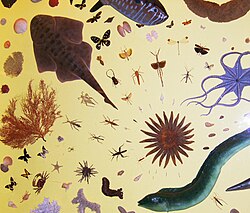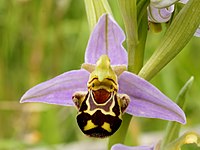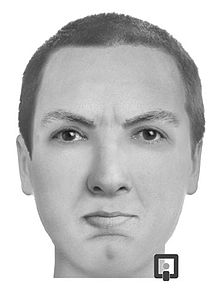Symmetry in biology


Symmetry in biologyrefers to the symmetry observed inorganisms,including plants, animals,fungi,andbacteria.External symmetry can be easily seen by just looking at an organism. For example, the face of a human being has a plane of symmetry down its centre, or a pine cone displays a clear symmetrical spiral pattern. Internal features can also show symmetry, for example the tubes in the human body (responsible for transportinggases,nutrients,and waste products) which arecylindricaland have several planes of symmetry.
Biological symmetry can be thought of as a balanced distribution of duplicate body parts or shapes within the body of an organism. Importantly, unlike in mathematics, symmetry in biology is always approximate. For example, plant leaves – while considered symmetrical – rarely match up exactly when folded in half. Symmetry is one class ofpatterns in naturewhereby there is near-repetition of the pattern element, either byreflectionorrotation.
Whilespongesandplacozoansrepresent two groups of animals which do not show any symmetry (i.e. are asymmetrical), thebody plansof mostmulticellular organismsexhibit, and are defined by, some form of symmetry. There are only a few types of symmetry which are possible in body plans. These areradial(cylindrical) symmetry,bilateral,biradial andsphericalsymmetry.[1]While the classification ofvirusesas an "organism" remains controversial, viruses also containicosahedral symmetry.
The importance of symmetry is illustrated by the fact that groups of animals have traditionally been defined by this feature intaxonomicgroupings. TheRadiata,animals with radial symmetry, formed one of the four branches ofGeorges Cuvier's classification of theanimalkingdom.[2][3][4]Meanwhile,Bilateriais a taxonomic grouping still used today to represent organisms withembryonicbilateral symmetry.
Radial symmetry[edit]
Organisms with radial symmetry show a repeating pattern around a central axis such that they can be separated into several identical pieces when cut through the central point, much like pieces of a pie. Typically, this involves repeating a body part 4, 5, 6 or 8 times around the axis – referred to as tetramerism, pentamerism, hexamerism and octamerism, respectively. Such organisms exhibit no left or right sides but do have a top and a bottom surface, or a front and a back.
George Cuvier classified animals with radial symmetry in the taxon Radiata (Zoophytes),[5][4]which is now generally accepted to be an assemblage of different animal phyla that do not share a single common ancestor (apolyphyleticgroup).[6]Most radially symmetric animals are symmetrical about an axis extending from the center of the oral surface, which contains the mouth, to the center of the opposite (aboral) end. Animals in the phylaCnidariaandEchinodermatagenerally show radial symmetry,[7]although manysea anemonesand somecoralswithin the Cnidaria have bilateral symmetry defined by a single structure, thesiphonoglyph.[8]Radial symmetry is especially suitable forsessileanimals such as the sea anemone, floating animals such asjellyfish,and slow moving organisms such asstarfish;whereas bilateral symmetry favourslocomotionby generating astreamlinedbody.
Many flowers are also radially symmetric, or "actinomorphic".Roughly identical floral structures –petals,sepals,andstamens– occur at regular intervals around the axis of the flower, which is often the femalereproductive organcontaining thecarpel,styleandstigma.[9]

Subtypes of radial symmetry[edit]
Three-fold triradial symmetry was present inTrilobozoafrom the LateEdiacaranperiod.
Four-fold tetramerism appears in some jellyfish, such asAureliamarginalis.This is immediately obvious when looking at the jellyfish due to the presence of fourgonads,visible through itstranslucentbody. This radial symmetry isecologicallyimportant in allowing the jellyfish to detect and respond tostimuli(mainly food and danger) from all directions.

Flowering plantsshow five-fold pentamerism, in many of their flowers and fruits. This is easily seen through the arrangement of fivecarpels(seed pockets) in anapplewhen cuttransversely.Among animals, only the echinoderms such assea stars,sea urchins,andsea liliesare pentamerous as adults, with five arms arranged around the mouth. Being bilaterian animals, however, they initially develop with mirror symmetry as larvae, then gain pentaradial symmetry later.[10]
Hexamerismis found in thecoralsandsea anemones(classAnthozoa), which are divided into two groups based on their symmetry. The most common corals in the subclassHexacoralliahave a hexameric body plan; theirpolypshave six-fold internal symmetry and a number oftentaclesthat is a multiple of six.
Octamerismis found in corals of the subclassOctocorallia.These have polyps with eight tentacles and octameric radial symmetry. Theoctopus,however, has bilateral symmetry, despite its eight arms.
Icosahedral symmetry[edit]

Icosahedral symmetry occurs in an organism which contains 60 subunits generated by 20 faces, each anequilateral triangle,and 12 corners. Within theicosahedronthere is2-fold, 3-fold and 5-fold symmetry.Many viruses, includingcanine parvovirus,show this form of symmetry due to the presence of an icosahedralviral shell.Such symmetry hasevolvedbecause it allows the viral particle to be built up of repetitive subunits consisting of a limited number of structuralproteins(encoded by viralgenes), thereby saving space in the viralgenome.The icosahedral symmetry can still be maintained with more than 60 subunits, but only in multiples of 60. For example, the T=3Tomato bushy stunt virushas 60x3 protein subunits (180 copies of the same structural protein).[11][12]Although these viruses are often referred to as 'spherical', they do not show true mathematical spherical symmetry.
In the early 20th century,Ernst Haeckeldescribed (Haeckel, 1904) a number of species ofRadiolaria,some of whose skeletons are shaped like various regular polyhedra. Examples includeCircoporus octahedrus,Circogonia icosahedra,Lithocubus geometricusandCircorrhegma dodecahedra.The shapes of these creatures should be obvious from their names. Tetrahedral symmetry is not present inCallimitra agnesae.
Spherical symmetry[edit]

Spherical symmetry is characterised by the ability to draw an endless, or great but finite, number of symmetry axes through the body. This means that spherical symmetry occurs in an organism if it is able to be cut into two identical halves through any cut that runs through the organism's center. True spherical symmetry is not found in animal body plans.[1]Organisms which show approximate spherical symmetry include the freshwater green algaVolvox.[7]
Bacteria are often referred to as having a 'spherical' shape. Bacteria are categorized based on their shapes into three classes: cocci (spherical-shaped), bacillus (rod-shaped) and spirochetes (spiral-shaped) cells. In reality, this is a severe over-simplification as bacterial cells can be curved, bent, flattened, oblong spheroids and many more shapes.[13]Due to the huge number of bacteria considered to be cocci (coccus if a single cell), it is unlikely that all of these show true spherical symmetry. It is important to distinguish between the generalized use of the word 'spherical' to describe organisms at ease, and the true meaning of spherical symmetry. The same situation is seen in the description of viruses – 'spherical' viruses do not necessarily show spherical symmetry, being usually icosahedral.
Bilateral symmetry[edit]
Organisms with bilateral symmetry contain a single plane of symmetry, thesagittal plane,which divides the organism into two roughly mirror image left and right halves – approximate reflectional symmetry.


Animals with bilateral symmetry are classified into a large group called thebilateria,which contains 99% of all animals (comprising over 32 phyla and 1 million described species). All bilaterians have some asymmetrical features; for example, the human heart and liver are positioned asymmetrically despite the body having external bilateral symmetry.[14]
The bilateral symmetry of bilaterians is a complex trait which develops due to theexpressionof manygenes.The bilateria have two axes ofpolarity.The first is ananterior-posterior(AP) axis which can be visualised as an imaginary axis running from the head or mouth to the tail or other end of an organism. The second is thedorsal-ventral(DV) axis which runsperpendicularto the AP axis.[15][1]During development the AP axis is always specified before the DV axis,[16]which is known as thesecond embryonic axis.
The AP axis is essential in defining the polarity of bilateria and allowing the development of a front and back to give the organism direction. The front end encounters the environment before the rest of the body so sensory organs such as eyes tend to be clustered there. This is also the site where a mouth develops since it is the first part of the body to encounter food. Therefore, a distinct head, with sense organs connected to a central nervous system, tends to develop.[17]This pattern of development (with a distinct head and tail) is calledcephalization.It is also argued that the development of an AP axis is important in locomotion – bilateral symmetry gives the body an intrinsic direction and allows streamlining to reducedrag.
In addition to animals, the flowers of some plants also show bilateral symmetry. Such plants are referred to aszygomorphicand include the orchid (Orchidaceae) and pea (Fabaceae) families, and most of the figwort family (Scrophulariaceae).[18][19]The leaves of plants also commonly show approximate bilateral symmetry.
Biradial symmetry[edit]
Biradial symmetry is found in organisms which show morphological features (internal or external) of both bilateral and radial symmetry. Unlike radially symmetrical organisms which can be divided equally along many planes, biradial organisms can only be cut equally along two planes. This could represent an intermediate stage in the evolution of bilateral symmetry from a radially symmetric ancestor.[20]
The animal group with the most obvious biradial symmetry is thectenophores.In ctenophores the two planes of symmetry are (1) the plane of the tentacles and (2) the plane of the pharynx.[1]In addition to this group, evidence for biradial symmetry has even been found in the 'perfectly radial' freshwater polypHydra(a cnidarian). Biradial symmetry, especially when considering both internal and external features, is more common than originally accounted for.[21]
Evolution of symmetry[edit]
Like all the traits of organisms, symmetry (or indeed asymmetry) evolves due to an advantage to the organism – a process ofnatural selection.This involves changes in thefrequencyof symmetry-related genes throughout time.
Evolution of symmetry in plants[edit]
Early flowering plants had radially symmetric flowers but since then many plants have evolved bilaterally symmetrical flowers. The evolution of bilateral symmetry is due to theexpressionofCYCLOIDEAgenes. Evidence for the role of theCYCLOIDEAgene family comes frommutationsin these genes which cause a reversion to radial symmetry. TheCYCLOIDEAgenes encodetranscription factors,proteins which control the expression of other genes. This allows their expression to influence developmental pathways relating to symmetry.[22][23]For example, inAntirrhinum majus,CYCLOIDEAis expressed during early development in the dorsal domain of the flowermeristemand continues to be expressed later on in the dorsal petals to control their size and shape. It is believed that the evolution of specialized pollinators may play a part in the transition of radially symmetrical flowers to bilaterally symmetrical flowers.[24]
Evolution of symmetry in animals[edit]

Symmetry is often selected for in the evolution of animals. This is unsurprising since asymmetry is often an indication of unfitness – either defects during development or injuries throughout a lifetime. This is most apparent during mating during which females of some species select males with highly symmetrical features. For example,facial symmetryinfluences human judgements of human attractiveness.[26]Additionally, femalebarn swallows,a species where adults have long tail streamers, prefer to mate with males that have the most symmetrical tails.[27]
While symmetry is known to be under selection, the evolutionary history of different types of symmetry in animals is an area of extensive debate. Traditionally it has been suggested that bilateral animals evolved from a radialancestor.Cnidarians,a phylum containing animals with radial symmetry, are the most closely related group to the bilaterians. Cnidarians are one of two groups of early animals considered to have defined structure, the second being thectenophores.Ctenophores show biradial symmetry leading to the suggestion that they represent an intermediate step in the evolution of bilateral symmetry from radial symmetry.[28]
Interpretations based only on morphology are not sufficient to explain the evolution of symmetry. Two different explanations are proposed for the different symmetries in cnidarians and bilateria. The first suggestion is that an ancestral animal had no symmetry (was asymmetric) before cnidarians and bilaterians separated into different evolutionarylineages.Radial symmetry could have then evolved in cnidarians and bilateral symmetry in bilaterians. Alternatively, the second suggestion is that an ancestor of cnidarians and bilaterians had bilateral symmetry before the cnidarians evolved and became different by having radial symmetry. Both potential explanations are being explored and evidence continues to fuel the debate.
Asymmetry[edit]
Although asymmetry is typically associated with being unfit, some species have evolved to be asymmetrical as an importantadaptation.Many members of the phylum Porifera (sponges) have no symmetry, though some are radially symmetric.[29]
| Group/Species | Asymmetrical Feature | Adaptive Benefit |
|---|---|---|
| Someowls[30] | Size and positioning of ears | Allows the owl to more precisely determine the location ofprey |
| Flatfish[31] | Both eyes on the same side of their head | Rest and swim on one side (to blend in with sand floor of the ocean) |
| The scale-eatingcichlidPerissodus microlepis[32] | Mouth and jaw asymmetry | More effective at removing scales from their prey |
| Humans[33][34][35] | Handednessand internal asymmetry of organs e.g. left lung is smaller than the right | Handedness is an adaptation reflecting the asymmetries of the human brain. |
| Allvertebrates | Internal asymmetry ofheartandbowels | Internal asymmetry is thought to be caused by a developmentalaxial twist.[36] |
-
Head of a malecrossbillshowing asymmetrical upper and lower beak
-
Awinter flounder,a type of flatfish, with both eyes on the same side of its head
-
Hermit crabs have different sized claws
-
ARoman snailand its helical shell
-
Chicoreus palmarosae,a sea snail, illustrating asymmetry, which is seen in allgastropodsin the form of a helical shell
-
Ared slug,clearly showing thepneumostome
-
Alife restorationofStegosaurus stenopswith its asymmetrical plates.
Symmetry breaking[edit]
The presence of these asymmetrical features requires a process of symmetry breaking during development, both in plants and animals. Symmetry breaking occurs at several different levels in order to generate the anatomical asymmetry which we observe. These levels include asymmetric gene expression, protein expression, and activity of cells.
For example, left-right asymmetry in mammals has been investigated extensively in theembryosof mice. Such studies have led to support for the nodal flow hypothesis. In a region of the embryo referred to as the node there are small hair-like structures (monocilia) that all rotate together in a particular direction. This creates a unidirectional flow of signalling molecules causing these signals to accumulate on one side of the embryo and not the other. This results in the activation of different developmental pathways on each side, and subsequent asymmetry.[38][39]

Much of the investigation of the genetic basis of symmetry breaking has been done on chick embryos. In chick embryos the left side expresses genes calledNODALandLEFTY2that activatePITX2to signal the development of left side structures. Whereas, the right side does not expressPITX2and consequently develops right side structures.[40][41]A more complete pathway is shown in the image at the side of the page.
For more information about symmetry breaking in animals please refer to theleft-right asymmetrypage.
Plants also show asymmetry. For example the direction of helical growth inArabidopsis,the most commonly studied model plant, shows left-handedness. Interestingly, the genes involved in this asymmetry are similar (closely related) to those in animal asymmetry – bothLEFTY1andLEFTY2play a role. In the same way as animals, symmetry breaking in plants can occur at a molecular (genes/proteins), subcellular, cellular, tissue and organ level.[42]
Fluctuating asymmetry[edit]

Fluctuating asymmetry(FA), is a form of biologicalasymmetry,along with anti-symmetry and direction asymmetry. Fluctuating asymmetry refers to small, random deviations away from perfect bilateral symmetry.[43][44]This deviation from perfection is thought to reflect the genetic and environmental pressures experienced throughout development, with greater pressures resulting in higher levels of asymmetry.[43]Examples of FA in the human body include unequal sizes (asymmetry) of bilateral features in the face and body, such as left and right eyes, ears, wrists,breasts,testicles,and thighs.
Research has exposed multiple factors that are associated with FA. As measuring FA can indicate developmental stability, it can also suggest the genetic fitness of an individual. This can further have an effect on mate attraction and sexual selection, as less asymmetry reflects greater developmental stability and subsequent fitness.[45]Humanphysical healthis also associated with FA. For example, young men with greater FA report more medical conditions than those with lower levels of FA.[46]Multiple other factors can be linked to FA, such as intelligence[45]and personality traits.[47]See also[edit]
Biological structures[edit]
- Standard anatomical position
- Anatomical terms of motion
- Anatomical terms of muscle
- Anatomical terms of bone
- Anatomical terms of neuroanatomy
- Glossary of botanical terms
- Glossary of plant morphology
- Glossary of leaf morphology
- Glossary of entomology terms
- Plant morphology
Terms of orientation[edit]
- Handedness
- Laterality
- Proper right and proper left
- Reflection symmetry
- Sinistral and dextral
- Direction (disambiguation)
- Symmetry (disambiguation)
References[edit]
Citations[edit]
- ^abcdHolló, Gábor (2015)."A new paradigm for animal symmetry".Interface Focus.5(6): 20150032.doi:10.1098/rsfs.2015.0032.PMC4633854.PMID26640644.
- ^McBirney, Alexander (2009).Georges Cuvier. In: The Philosophy of Zoology Before Darwin.Springer, Dordrecht. pp. 87–98.
- ^Waggoner, Ben M."Georges Cuvier (1769–1832)".UCMP Berkeley.Retrieved8 March2018.
Cuvier's insistence on the functional integration of organisms led him to classify animals into four "branches," or embranchements: Vertebrata, Articulata (arthropods and segmented worms), Mollusca (which at the time meant all other soft, bilaterally symmetrical invertebrates), and Radiata (cnidarians and echinoderms).
- ^abCuvier, Georges;Griffith, Edward; Pidgeon, Edward (1834).The Mollusca and Radiata: Arranged by the Baron Cuvier, with Supplementary Additions to Each Order.Whittaker and Company. pp. 435–.
- ^Waggoner, Ben M."Georges Cuvier (1769–1832)".UCMP Berkeley.Retrieved8 March2018.
Cuvier's insistence on the functional integration of organisms led him to classify animals into four "branches," or embranchements: Vertebrata, Articulata (arthropods and segmented worms), Mollusca (which at the time meant all other soft, bilaterally symmetrical invertebrates), and Radiata (cnidarians and echinoderms).
- ^Hadzi, J. (1963).The Evolution of the Metazoa.Macmillan. pp.56–57.ISBN978-0-08-010079-1.
- ^abChandra, Girish (11 October 2008)."Symmetry".IAS.Retrieved14 June2014.
- ^Finnerty, J.R. (2003). "The origins of axial patterning in the metazoa: How old is bilateral symmetry?".The International Journal of Developmental Biology.47(7–8): 523–9.PMID14756328.14756328 16341006.
- ^Endress, P. K. (February 2001). "Evolution of Floral Symmetry".Current Opinion in Plant Biology.4(1): 86–91.doi:10.1016/S1369-5266(00)00140-0.PMID11163173.
- ^Stewart, 2001. pp 64–65.
- ^Alan J Cann (2015)."Virus Structure".eLS.American Cancer Society. pp. 1–9.doi:10.1002/9780470015902.a0000439.pub2.ISBN978-0-470-01590-2.
- ^Horne, R. W.; Wildy, P. (November 1961). "Symmetry in virus architecture".Virology.15(3): 348–373.doi:10.1016/0042-6822(61)90366-X.PMID14448959.
- ^Young, K. D. (2006)."The Selective Value of Bacterial Shape".Microbiology and Molecular Biology Reviews.70(3): 660–703.doi:10.1128/MMBR.00001-06.PMC1594593.PMID16959965.
- ^Valentine, James W."Bilateria".AccessScience. Archived fromthe originalon 18 January 2008.Retrieved29 May2013.
- ^Finnerty, John R (2003)."Evolution & Development".IJDB.47:465–705.
- ^Freeman, Gary (2009). "The rise of bilaterians".Historical Biology.21(1–2): 99–114.doi:10.1080/08912960903295843.S2CID83841216.
- ^Finnerty, John R. (2005). "Did internal transport, rather than directed locomotion, favor the evolution of bilateral symmetry in animals?".BioEssays.27(11): 1174–1180.doi:10.1002/bies.20299.PMID16237677.
- ^"SCROPHULARIACEAE – Figwort or Snapdragon Family".Texas A&M University Bioinformatics Working Group.Retrieved14 June2014.
- ^Symmetry, biological,fromThe Columbia Electronic Encyclopedia(2007).
- ^Martindale, Mark Q.; Henry, Jonathan Q. (1998)."The Development of Radial and Biradial Symmetry: The Evolution of Bilaterality1".American Zoology.38(4): 672–684.doi:10.1093/icb/38.4.672.
- ^Watanabe, Hiroshi; Schmidt, Heiko A.; Kuhn, Anne; Höger, Stefanie K.; Kocagöz, Yigit; Laumann-Lipp, Nico; Özbek, Suat; Holstein, Thomas W. (24 August 2014). "Nodal signalling determines biradial asymmetry in Hydra".Nature.515(7525): 112–115.Bibcode:2014Natur.515..112W.doi:10.1038/nature13666.PMID25156256.S2CID4467701.
- ^Cubas, Pilar; Vincent, Coral; Coen, Enrico (1999). "An epigenetic mutation responsible for natural variation in floral symmetry".Nature.401(6749): 157–161.Bibcode:1999Natur.401..157C.doi:10.1038/43657.PMID10490023.S2CID205033495.
- ^Citerne, H (2000)."Diversity of cycloidea-like Genes in Gesneriaceae in Relation to Floral Symmetry".Annals of Botany.86:167–176.doi:10.1006/anbo.2000.1178.
- ^Hileman, Lena C; Cubas, Pilar (2009)."An expanded evolutionary role for flower symmetry genes".Journal of Biology.8(10): 90.doi:10.1186/jbiol193.PMC2790833.PMID19895716.
- ^Ivantsov, A. Yu.; Zakrevskaya, M. A. (2021)."Trilobozoa, Precambrian Tri-Radial Organisms".Paleontological Journal.55(7): 727–741.doi:10.1134/S0031030121070066.S2CID245330736.
- ^Grammer, K.; Thornhill, R. (1994). Human (Homo sapiens) facial attractiveness and sexual selection: the role of symmetry and averageness. Journal of comparative psychology (Washington, D.C.: 1983), 108(3), 233–42.
- ^Maynard Smith, John;Harper, David (2003).Animal Signals.Oxford University Press. pp. 63–65.
- ^Martindale, Mark Q.; Henry, Jonathon Q (1998)."The Development of Radial and Biradial Symmetry: The Evolution of Bilaterality".American Zoologist.38(4): 672–684.doi:10.1093/icb/38.4.672.
- ^Myers, Phil (2001)."Porifera Sponges".University of Michigan (Animal Diversity Web).Retrieved14 June2014.
- ^Norberg, R (1997). "Skull asymmetry, ear structure and function, and auditory localization in Tengmalm's owl, (Linné)".Philosophical Transactions of the Royal Society of London. B, Biological Sciences.282:325–410.doi:10.1098/rstb.1978.0014.
- ^Friedman, Matt (2008). "The evolutionary origin of flatfish asymmetry".Nature.454(7201): 209–212.Bibcode:2008Natur.454..209F.doi:10.1038/nature07108.PMID18615083.S2CID4311712.
- ^Lee, H. J.; Kusche, H.; Meyer, A. (2012)."Handed Foraging Behavior in Scale-Eating Cichlid Fish: Its Potential Role in Shaping Morphological Asymmetry".PLOS ONE.7(9): e44670.Bibcode:2012PLoSO...744670L.doi:10.1371/journal.pone.0044670.PMC3435272.PMID22970282.
{{cite journal}}:CS1 maint: multiple names: authors list (link) - ^Zaidel, E. (2001). "Brain Asymmetry".International Encyclopedia of the Social & Behavioral Sciences.Elsevier. pp. 1321–1329.doi:10.1016/b0-08-043076-7/03548-8.ISBN978-0-08-043076-8.
- ^Betts, J. Gordon (2013).Anatomy & physiology.pp. 787–846.ISBN978-1-938168-13-0.Retrieved11 August2014.
- ^Holder, M. K. (1997)."Why are more people right-handed?".Scientific American.Retrieved14 April2008.
- ^de Lussanet, M. H. E.; Osse, J. W. M. (2012). "An ancestral axial twist explains the contralateral forebrain and the optic chiasm in vertebrates".Animal Biology.62(2): 193–216.arXiv:1003.1872.doi:10.1163/157075611X617102.S2CID7399128.
- ^Goss, Richard J. (1 June 1990)."Interactions between asymmetric brow tines in caribou and reindeer antlers".Canadian Journal of Zoology.68(6): 1115–1119.doi:10.1139/z90-165.ISSN0008-4301.
- ^Hirokawa, Nobutaka; Tanaka, Yosuke; Okada, Yasushi; Takeda, Sen (2006)."Nodal Flow and the Generation of Left-Right Asymmetry".Cell.125(1): 33–45.doi:10.1016/j.cell.2006.03.002.PMID16615888.S2CID18007532.
- ^Nonaka, Shigenori; Shiratori, Hidetaka; Saijoh, Yukio; Hamada, Hiroshi (2002). "Determination of left–right patterning of the mouse embryo by artificial nodal flow".Nature.418(6893): 96–99.Bibcode:2002Natur.418...96N.doi:10.1038/nature00849.PMID12097914.S2CID4373455.
- ^Raya, Angel; Izpisua Belmonte, Juan Carlos (2004). "Unveiling the establishment of left–right asymmetry in the chick embryo".Mechanisms of Development.121(9): 1043–1054.doi:10.1016/j.mod.2004.05.005.PMID15296970.S2CID15417027.
- ^Gros, J.; Feistel, K.; Viebahn, C.; Blum, M.; Tabin, C. J. (2009)."Cell Movements at Hensen's Node Establish Left/Right Asymmetric Gene Expression in the Chick".Science.324(5929): 941–944.Bibcode:2009Sci...324..941G.doi:10.1126/science.1172478.PMC2993078.PMID19359542.
- ^Muñoz-Nortes, Tamara; Wilson-Sánchez, David; Candela, Héctor; Micol, José Luis (2014)."Symmetry, asymmetry, and the cell cycle in plants: known knowns and some known unknowns".Journal of Experimental Botany.65(10): 2645–2655.doi:10.1093/jxb/ert476.PMID24474806.
- ^abValen, Leigh Van (June 1962). "A Study of Fluctuating Asymmetry".Evolution.16(2): 125–142.doi:10.2307/2406192.JSTOR2406192.
- ^Tomkins, J. L.; Kotiaho, J. S. (2001).Fluctuating Asymmetry.London: Macmillan Publishers Ltd. pp. 1–5.
- ^abThornhill, Gangestad, Randy, Steven W. (2008).The evolutionary biology of human female sexuality.Oxford, England: Oxford University Press. pp. 162–168.ISBN978-0195340983.
{{cite book}}:CS1 maint: multiple names: authors list (link) - ^Milne, Barry J; Belsky, Jay; Poulton, Richie; Thomson, W. Murray; Caspi, Avshalom; Kieser, Jules (January 2003). "Fluctuating asymmetry and physical health among young adults".Evolution and Human Behavior.24(1): 53–63.doi:10.1016/S1090-5138(02)00120-4.
- ^Fink, Bernhard; Neave, Nick; Manning, John T.; Grammer, Karl (1 August 2005). "Facial symmetry and the 'big-five' personality factors".Personality and Individual Differences.39(3): 523–529.doi:10.1016/j.paid.2005.02.002.
Sources[edit]
- Ball, Philip(2009).Shapes.Oxford University Press.
- Stewart, Ian(2007).What Shape is aSnowflake?Magical Numbers in Nature.Weidenfeld and Nicolson.
- Thompson, D'Arcy(1942).On Growth and Form.Cambridge University Press.
- Haeckel, Ernst,E. (1904).Kunstformen der Natur.Available as Haeckel, E. (1998);Art forms in nature,Prestel US.ISBN3-7913-1990-6.









